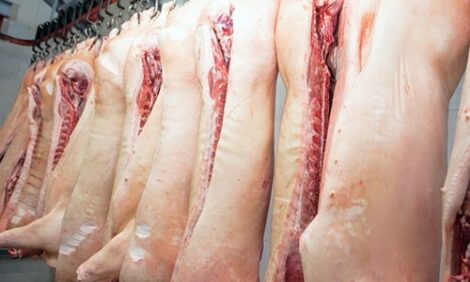



Weekly Roberts Market Report
US - The grain industry wants futures to have a one-hour futures trading pause after the release of the WASDE report, writes Michael Roberts.LEAN HOGS on the CME finished up on Monday. JULY’12LH futures closed at $96.800/cwt; up $0.575/cwt but $0.100/cwt lower than last report. AUG’12LH futures finished $0.650/cwt higher at $93.950/cwt but $1.025/cwt lower than last Monday’s close. The DEC’12LH contract closed at $82.00/cwt; up $1.700/cwt and $1.550/cwt higher than last report. Futures rallied Monday on signs that the historic summer heat will continue to make hogs lighter at processing. In addition, rising feed costs in combination with the heat may pressure producers to lower supply. The hot weather is stressing hogs on the farms and limiting their ability to gain weight. The USDA estimated the average hog was one pound lighter at slaughter last week compared to the week before. Nearbys were also supported by a discount to cash prices, which converge with futures as a contract nears expiration. Cash hog bids in the Midwest ranged from flat to $1 lower. USDA late Monday put the carcass cutout value at $89.87/cwt, off $0.26/cwt and $11.42/cwt lower than two weeks ago. The latest CME lean hog index was estimated at 100.58; down 0.08 and 1.53 lower than last report. The CME two-day lean-hog index determines the value of futures at expiration. July hog futures expire in seven days.

This table shows the maximum price a producer could pay for feeder cattle and still break even, assuming the costs and conversion/performance factors listed above. Producers should remain aware that calculations are based on averages. Courtesy DTN.
CORN futures on the Chicago Board of Trade (CBOT) closed up again on Monday. The JULY’12 contract closed at $7.750/bu; up 32.0¢/bu and 821.75¢/bu over last report. The DEC’12 contract closed at $7.300/bu; up 36.75¢/bu and 74.5¢/bu over last Monday’s close. Weakness in outside markets limited gains. USDA will issue it World Agriculture Supply Demand Estimates Wednesday, July 11. USDA is expected to drop its yield production forecast by 7.2 per cent. Hot weather seen as limiting supply is greatly affecting prices. USDA reports corn in 18 states are hurt by the drought reporting that 30 per cent of the US corn crop in poor-to-very-poor condition. The same rating was 22 per cent this time last week. The amount of US corn rated in good-to-excellent condition was put at 40 per cent vs. 48 per cent a week ago. The grain industry wants futures to have a one-hour futures trading pause after the release of the report. Most pit sources say they and the large funds expect USDA to cut production forecasts by as much as 7.5 per cent for US corn. Commercial traders are pushing the markets higher while non-commercials are buying enough to keep pace. The national average basis for corn fell 5.0¢/bu to 10.0¢/bu over September futures. Exports were neutral with USDA putting corn-inspected-for-export at 22.845 mb vs. estimates for 20-25 mb compared to the 36.6 mb needed to keep past with USDA’s demand projection of 1.65 bb for the 2011-2012 marketing year. Please see chart:

It would be a good time to consider pricing more of the 2012 crop.
SOYBEAN futures on the Chicago Board of Trade (CBOT) closed up on Monday. The JULY’12 contract closed at $16.550/bu; up 45.25¢/bu and $1.228/bu over last Monday. NOV’12 futures closed at $15.476/bu; up 42.0¢/bu and $1.096/bu over last report. The soybean crop is stressed as well. And, like corn, trader worries drove prices to a new record on Monday. USDA reported that 27 per cent of the US soybean crop was in poor-to-very-poor condition vs. 22 per cent this time last week. Only 40 per cent of the crop was in good-to-excellent condition. Soybeans are flowering and this is a very critical time for yield potential and development. USDA is expected to cut yield forecasts for the US soybean crop by 3.6 per cent due to the drought. While corn dominated the news soybeans remained bullish and the one most pit sources tell me they are concerned about. The inverse in the new-crop forward curve strengthened, with the November extending its premium over the July 2013 contract by almost $1.50/bu. Strong buying was seen in the soybean meal market as well. Exports were viewed as bullish. USDA put soybeans-inspected-for-export at 18.9 mb vs. estimates for 10-15 mb. This well above the 13.3 mb needed to stay on pace with USDA’s demand projection of 1.335 bb for the 2011-12 marketing years. Please see chart:

Cash prices are rallying on a weak dollar and dry weather in South America that is expected to reduce South American crop production. It might be a good idea to sell the rally.
WHEAT futures in Chicago (CBOT) closed up on Monday. JULY’12 wheat futures finished at $8.106/bu; up 19.5¢/bu and 56.25¢/bu over last report. The JULY’13 contract closed at $8.310/bu; up 13.25¢/bu and 30.5¢/bu over this time last week. Farmers have harvested 75 per cent of the US winter wheat crop as of Sunday vs. 56 per cent harvested this time last year. This is up from 69 per cent a week ago. Kansas says its winter wheat harvest is complete. USDA put the US wheat crop in good-to-excellent condition at 66 per cent vs. 71 per cent this time last week. Hot weather in the US and severe floods in Russia’s wheat basket region in Krasnodar are pushing world wheat prices higher. The September CBOT contract gained again on the December 2012 contract, showing solid demand both domestically and overseas. Higher corn and feed prices are also driving wheat prices as if corn gets much more expensive producers will feed more feed-grain wheat. This greater demand vs. lower production is expected to weaken global wheat stocks and support higher prices. USDA put wheat-inspected-for-export at 14.898 mb vs. estimates for 18-24 mb. Weekly exports needed to stay on pace with USDA’s demand projections of 1.15 bb are 22.2 mb. This is 7.3 mb more than was exported this week. It would be a very good time to price some of the 2012 wheat crop.









